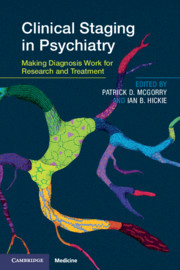Book contents
- Clinical Staging in Psychiatry
- Clinical Staging in Psychiatry
- Copyright page
- Contents
- Contributors
- Foreword
- Acknowledgements
- Section 1 Conceptual and Strategic Issues
- Section 2 Progress with Clinical Staging
- Chapter 5 The Utility of Clinical Staging in Youth Mental Health Settings
- Chapter 6 Neuroimaging and Staging
- Chapter 7 Staging of Cognition in Psychiatric Illness
- Chapter 8 Neuroinflammation and Staging
- Chapter 9 Bioactive and Inflammatory Markers in Emerging Psychotic Disorders
- Chapter 10 Electroencephalography and Staging
- Section 3 Novel Treatment Strategies
- Section 4 Novel Treatment Strategies
- Index
- Plate Section (PDF Only)
- References
Chapter 8 - Neuroinflammation and Staging
from Section 2 - Progress with Clinical Staging
Published online by Cambridge University Press: 08 August 2019
- Clinical Staging in Psychiatry
- Clinical Staging in Psychiatry
- Copyright page
- Contents
- Contributors
- Foreword
- Acknowledgements
- Section 1 Conceptual and Strategic Issues
- Section 2 Progress with Clinical Staging
- Chapter 5 The Utility of Clinical Staging in Youth Mental Health Settings
- Chapter 6 Neuroimaging and Staging
- Chapter 7 Staging of Cognition in Psychiatric Illness
- Chapter 8 Neuroinflammation and Staging
- Chapter 9 Bioactive and Inflammatory Markers in Emerging Psychotic Disorders
- Chapter 10 Electroencephalography and Staging
- Section 3 Novel Treatment Strategies
- Section 4 Novel Treatment Strategies
- Index
- Plate Section (PDF Only)
- References
Summary
The staging model of mental illness is developing beyond the clinical level aiming to include biological processes and markers that may reflect the dynamic biological processes of stages of mental illness. The neurobiology of inflammation in mental illness has gained much attention in recent years. Since neuroinflammation has been shown to be an important possible feature of psychosis, schizophrenia and depression, in this chapter it is attempted to map changes and dysregulation of the immune system and inflammation to the different clinical stages of severe mental illness. The literature suggests that an increased inflammatory response may define a subgroup of individuals in ultra-high-risk states, in acute disease episodes and in those with severe mental illness. In addition, the literature clearly points to the dynamic nature of the immune response in mental illness and shows an involvement of both the innate and adaptive immune system in mental illness. A focus on inflammation only might be insufficient and a broader understanding of the interaction between innate and adaptive immune systems and the complex neuroimmune interaction is required.
Keywords
- Type
- Chapter
- Information
- Clinical Staging in PsychiatryMaking Diagnosis Work for Research and Treatment, pp. 172 - 190Publisher: Cambridge University PressPrint publication year: 2019



